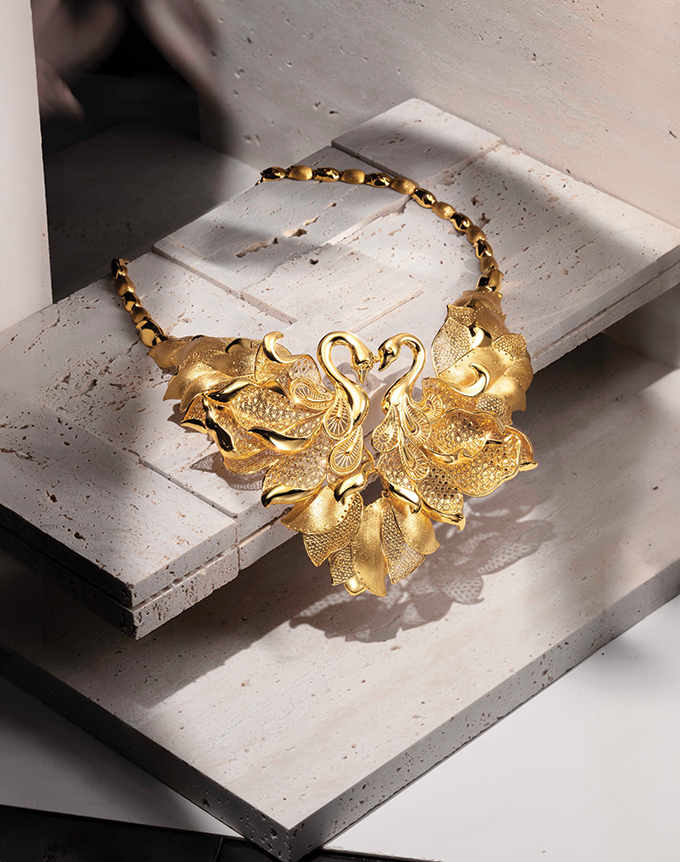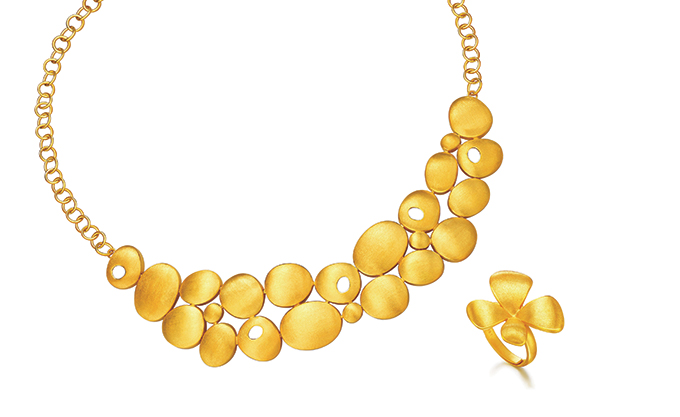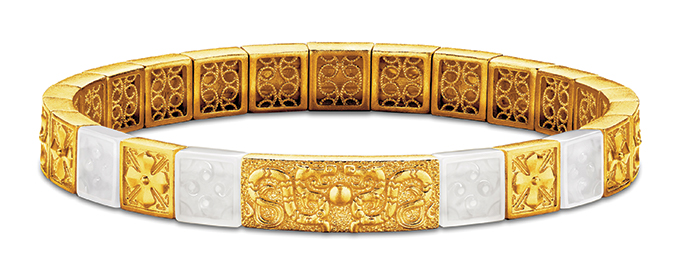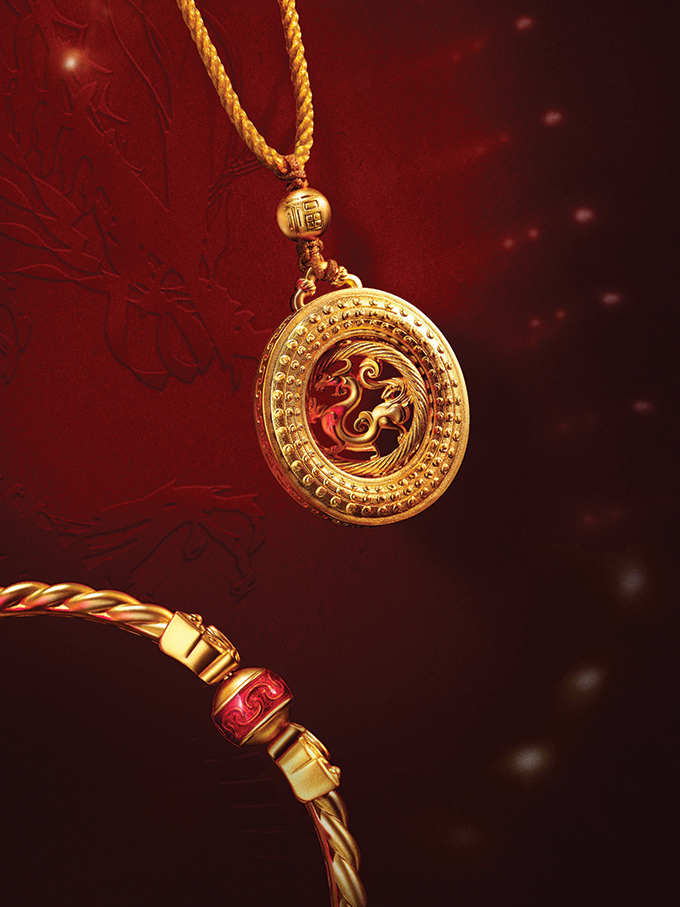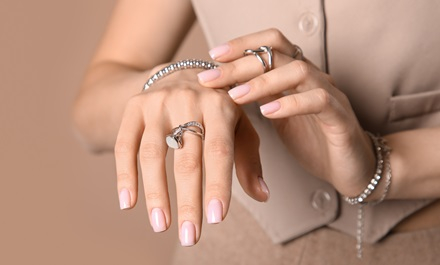China’s passion for 24-karat gold is undeniable and unparalleled. Pure gold jewellery reaffirms its dominance in the market through innovative craftsmanship and contemporary designs.
This article first appeared in the JNA March/April 2024 issue.
Pure gold jewellery, which has long held pride of place in China, is undergoing a major transformation that is expanding its reach and appeal to younger generations of consumers.
Technological innovation is spurring the emergence of fashionable designs embodying the highly popular China-chic trend known as Guochao or blending Eastern and Western aesthetics, refuting misconceptions of 24-karat gold jewellery as conservative and old-fashioned. These modern styles are increasingly winning over younger consumers who seek stylish creations that resonate with their personalities and values.
According to Chow Tai Fook Jewellery Group’s 2023 Jewellery Consumer Trends Report, “Shaping the Future of Jewellery Consumption in China and Beyond: Preferences and Desires of Generation Z and Millennials,” 67 per cent of 18- to 40-year-olds planned to purchase pure gold jewellery; 77 per cent would choose pure gold jewellery to celebrate important life events; and 61 per cent wear pure gold jewellery in their daily lives. This shift signals the tremendous and sustained market potential for gold jewellery in China as Gen Z individuals and millennials become the country’s main consumer segments.
At the same time, gold’s intrinsic value as a safe-haven asset and an investment tool, coupled with rising gold prices, continues to stimulate the market. The wide range of gold products and fineness that accommodate various budgets further fuels demand amid more conservative spending habits post-Covid.
Wu Fenghua, founder and art director of TTF Haute Joaillerie, pointed to a growing trend of design-centric jewellery, noting that younger consumers are now gravitating towards pure gold jewellery that is both fashionable and preserves its value.
Retail strength
Gold jewellery’s impressive sales performance also justifies its prominence in retail inventories. A recent World Gold Council (WGC) report, “2023 Chinese Jewellery Market Insights,” which surveyed 538 store managers and regional marketing directors from 76 cities in China, found that gold jewellery accounted for 67 per cent of retail inventory value, a significant increase from 52 per cent in 2021. Diamond jewellery came in second, at 17 per cent.
According to the report, 24-karat heritage gold jewellery, which features ancient Chinese goldsmithing techniques, made up 27.9 per cent of retailers’ gold inventory value. Meanwhile, 24-karat hard pure gold jewellery pieces that are relatively lighter in weight accounted for 22.6 per cent, while usual 24-karat gold jewellery brought in 24.1 per cent. Jewellery pieces in 18-karat and 22-karat gold constituted 12.2 per cent of gold jewellery stock in retailers' stores.
Hard pure gold jewellery contributes the most to retailers’ overall profits due to its contemporary designs and lighter weight, making it more affordable and accessible. Heritage gold jewellery is a close second. Usual pure gold jewellery also remains an important product category for most retailers as older consumers comprise a significant portion of the Chinese gold jewellery market.
Over 50 per cent of Chow Tai Fook’s loyalty programme members under the age of 35 purchased jewellery from its HUÁ Collection, which combines traditional craftsmanship with modern aesthetics. In the first half of the group’s financial year 2024, the HUÁ Collection accounted for approximately 37 per cent of the group’s gold retail sales value on the mainland.
Store of wealth
WGC cited two reasons for the popularity of gold jewellery in China — it can be worn daily and is a financial asset for value preservation.
Given current uncertainties, more Chinese consumers are choosing to save. And on the heels of its 10 per cent increase in 2022, RMB gold rose more than 17 per cent in 2023, far exceeding other RMB assets.
These factors, coupled with younger generations' heightened awareness of wealth management, have enhanced gold’s standing among consumers, leading to steady growth in its share in jewellery retail inventories.
Instead of traditional gold bars, more young people are buying budget-friendly "gold beans” of 1 or 2 grams and keep these in a “gold saving bottle,” which is veritably a modern piggy bank. These affordable options significantly lower the threshold for investing in gold, allowing younger consumers to develop the habit of buying gold on a regular basis.
Moreover, the WGC report found that 66 per cent of gold jewellery on the mainland is priced per gram, up from 57 per cent in 2021, making gold jewellery prices transparent and easy to compare. The smooth trade-in system for brand new pieces or cash also provides a sense of security.
In 2023, gold jewellery under RMB2,000 (around US$284) comprised over 35 per cent of retail sales, almost doubling from 2022. For their part, products priced between RMB2,000 (around US$284) and RMB5,000 (around US$710) accounted for 28 per cent of total sales.
Lightweight products, especially those under 10 grams, are particularly favoured for their affordability and the intricate, stylish and modern designs now possible through technological innovation.
Wedding fortunes
Gold also remains crucial to the wedding market due to its cultural and economic significance. Couples are often gifted a three-piece gold jewellery set of ring, necklace and bangle, following the “marriage, three gold” tradition that generates significant sales in terms of weight and value.
Data from Chow Tai Fook indicated that, while daily-wear demand has risen, the wedding market remains one of the key drivers of gold jewellery sales, accounting for approximately 20 per cent of the group's retail value. Its consumer trends report found that pure gold jewellery remains Chinese consumers’ first choice for important occasions. Pure gold jewellery is generally preferred to show respect to visitors. Moreover, in traditional Chinese weddings, gold is symbolic of family members’ blessings for the new couple.
Growing market
Innovation and design likewise play a critical role in expanding the reach and appeal of gold jewellery.
“Chow Tai Fook Jewellery Group never stops designing products. We start from aspects such as aesthetics and culture and then add design elements that reflect market needs like national trends and cultural innovation. A good design concept must however be complemented by skilled craftsmen and an excellent technical research and development team in order to create it,” said Kent Wong, managing director of Chow Tai Fook Jewellery Group.
The Vickers hardness of regular pure gold is about 40HV, while that of hard pure gold can reach 60HV or higher. Hard pure gold jewellery thus becomes less prone to scratches, wear and deformation, achieving a lustre similar to 18-karat gold and enabling the production of diverse designs at lighter weights.
“Traditional handcraftsmanship, lost-wax casting, CNC machining and electroforming can now be used on 24-karat gold to produce more delicate pieces,” remarked Wu of TTF Haute Joaillerie.
Hard pure gold jewellery increasingly resonates among younger consumers, reflecting their confidence and independence, said WGC China Managing Director Roland Wang. “They dare to challenge, dare to break through, dare to pursue love, dare to live, dare to be themselves, and maintain their own 'hard' attitude. They welcome change, refuse to be stereotyped and boldly embrace unlimited possibilities,” he explained.
Chow Tai Fook has likewise sharpened its focus on the younger generation of consumers.
“We have not only kept abreast of the times in product design but also made active use of social media such as Xiaohongshu and TikTok to promote our products in order to align with the shopping habits of young people,” said Wong. “We also cooperated with influential Key Opinion Leaders (KOLs) or Key Opinion Consumers (KOCs) to strengthen online customer interactions, thereby expanding our online presence and strengthening our ties with young people.”
Shining path ahead
Prospects for China’s gold market are bright this year, with 58 per cent of the store managers and marketing directors surveyed in the WGC report intending to increase their inventory of gold products.
Competition and lower margins, however, are likely to ensue as retailers generally have their own product lines of heritage gold and hard pure gold jewellery.
An influx of new product innovations could help sustain the momentum of gold jewellery sales, said Wang of WGC. Already, jewellers are combining various goldsmithing techniques in single jewellery pieces or incorporating other materials and gems in their 24-karat gold jewellery.
“The Chinese market is likely to use 24-karat gold for contemporary styles currently produced in 14-karat or 18-karat gold and develop a new global category under the banner of Guochao,” said TTF Haute Joaillerie’s Wu.
Chow Tai Fook’s gold jewellery sales in the third quarter of its financial year 2024 from October to December 2023 was driven largely by strong demand for key product ranges such as the HUÁ Collection and the ING Collection, which saw retail sales value increase by more than 50 per cent and 40 per cent, respectively. Its same-store sales of gold jewellery and products on the mainland rose by 32.5 per cent, while the average selling price remained resilient, increasing to HK$5,600 (around US$715).
Chow Tai Fook’s 2023 Jewellery Consumer Trends Report noted that 91 per cent of consumers aged 18 to 40 preferred to purchase jewellery with elements reflecting Chinese cultural heritage.
The group collaborates with museums and universities to understand and revive ancient gold craftsmanship techniques, promoting the sustainable development of the industry while preserving this precious legacy for future generations. “Chow Tai Fook will continue to use gold to tell the Chinese story and create products that meet the emotional needs of the public,” said Wong.




